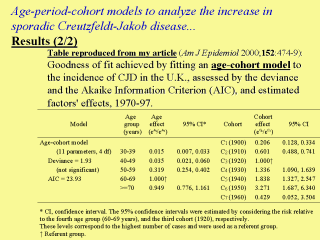| front |1 |2 |3 |4 |5 |6 |7 |8 |9 |10 |11 |12 |13 |14 |15 |16 |17 |review |
 |
The
age-cohort model relied on the two
extreme assumptions:
1)
there was no period factor (no past reporting bias involved in the
incidence trend) and
2)
past variations in exposure to an unknown etiologic factor were
involved in the incidence trend.
The
age-cohort model indicated that a cohort
factor increased over the first half of the 20th century
(e.g., the incidence in the generation born in 1940 was almost twice
that in the generation born in 1920).
This increase
was probably an artifact due to the past under-ascertainment pattern.
However, from a
statistical viewpoint, both models led to a satisfactory fit to the
data. The cohort factor may appear as relevant as the period factor in
describing the incidence trends.
|